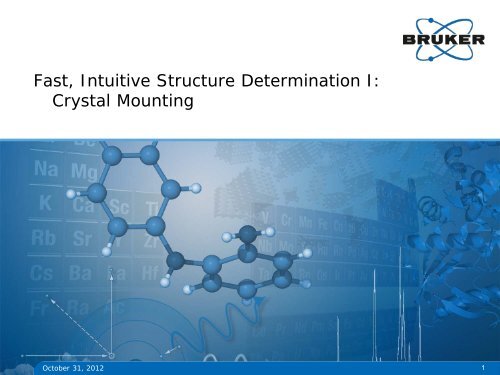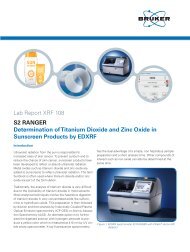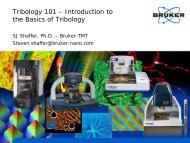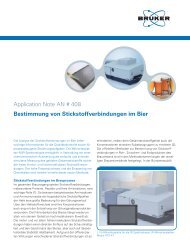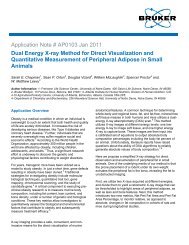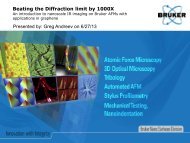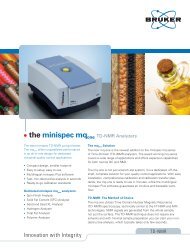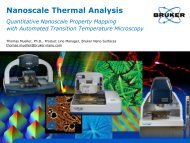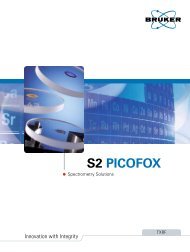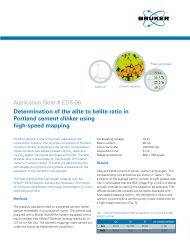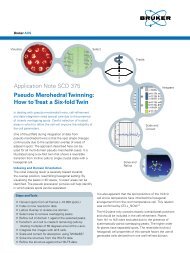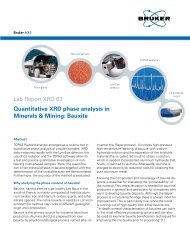Bruker AXS Fast Intuitive Structure Determination I Crystal Mounting ...
Bruker AXS Fast Intuitive Structure Determination I Crystal Mounting ...
Bruker AXS Fast Intuitive Structure Determination I Crystal Mounting ...
Create successful ePaper yourself
Turn your PDF publications into a flip-book with our unique Google optimized e-Paper software.
<strong>Fast</strong>, <strong>Intuitive</strong> <strong>Structure</strong> <strong>Determination</strong> I:<br />
<strong>Crystal</strong> <strong>Mounting</strong><br />
October 31, 2012 1
Welcome<br />
Dr. Michael Ruf<br />
Product Manager – <strong>Crystal</strong>lography<br />
<strong>Bruker</strong> <strong>AXS</strong> Inc.<br />
Madison, WI, USA<br />
Dr. Bruce Noll<br />
Sr. Applications Scientist – <strong>Crystal</strong>lography<br />
<strong>Bruker</strong> <strong>AXS</strong> Inc.<br />
Madison, WI, USA<br />
October 31, 2012<br />
2
Overview<br />
• Properly sized and mounted crystals<br />
improve data quality.<br />
• Minimize absorption effects.<br />
• Reduce background scatter.<br />
• Improve strategy optimization.<br />
October 31, 2012 3
Overview<br />
• Small-molecule crystals<br />
• Tools and equipment<br />
• <strong>Crystal</strong> supports<br />
• Adhesives<br />
• Selecting crystals<br />
• Cutting crystals<br />
• <strong>Mounting</strong> crystals<br />
October 31, 2012 4
Growing <strong>Crystal</strong>s<br />
• Growing and <strong>Mounting</strong> Single <strong>Crystal</strong>s Your Diffractometer Will Treasure<br />
• www.bruker.com/service/education-training/webinars/sc-xrd.html<br />
Dr. Richard J. Staples<br />
<strong>Crystal</strong>lographer<br />
Department of Chemistry<br />
Michigan State University<br />
East Lansing, MI, USA<br />
staples@chemistry.msu.edu<br />
October 31, 2012 5
The microscope<br />
• Microscope<br />
requirements:<br />
• Good quality optics<br />
• 60-100x<br />
magnification<br />
• Polarizing stage<br />
• Good working height<br />
• Good light<br />
October 31, 2012 6
Tools<br />
• Few tools needed<br />
• Manipulation<br />
• Micro-tools<br />
• Dissecting needles<br />
• Pin vise/sewing<br />
needles<br />
• Acupuncture needles<br />
• <strong>Crystal</strong> cutting<br />
• Single-edge razor<br />
blade<br />
• Scalpel<br />
• X-acto knife<br />
October 31, 2012 7
Choosing tools<br />
• Comfortable to grip<br />
• Easy to handle<br />
• Matched to sample<br />
• Smaller tools for small<br />
specimens<br />
• Larger tools for large<br />
specimens<br />
October 31, 2012 8
Handling tools<br />
• Pin vise needs just a light<br />
grip<br />
• Mass reduces vibration<br />
• Acupuncture needle gripped<br />
more tightly<br />
• Easy to flex with fingertips<br />
October 31, 2012<br />
9
Cutting tools<br />
• Easy to handle<br />
• Easy to position<br />
• Precise cutting<br />
October 31, 2012 10
<strong>Mounting</strong> crystals<br />
• Choice of adhesive affects<br />
background scatter and ease<br />
of handling.<br />
• For room temperature:<br />
• Epoxy<br />
• Cyanoacrylate (Super<br />
Glue)<br />
• UV-curable adhesives<br />
October 31, 2012 11
<strong>Mounting</strong> for low temperature<br />
• Cryocrystallography allows<br />
for easy handling of<br />
routine and sensitive<br />
samples<br />
• Material must harden or<br />
“glass” at experimental<br />
temperature<br />
• Suitable compounds:<br />
• Hydrocarbon oil<br />
• Paratone-N<br />
• STP engine additive<br />
• Grease<br />
• High-vacuum<br />
grease<br />
• Apiezon<br />
• Fluorolube<br />
• Fomblin<br />
• Karo syrup<br />
October 31, 2012 12
Choosing a mount<br />
There are many options to support the crystal in the instrument.<br />
October 31, 2012<br />
13
Choices for mounts<br />
• Different mounts have different<br />
properties.<br />
• Glass fiber<br />
• Inexpensive<br />
• Easy to make on demand<br />
• Fragile<br />
• Background scatter<br />
• Monofilament loops<br />
• $ 1.00 unmounted<br />
• $ 7.00 on pin<br />
• Polyimide mounts (MiTeGen)<br />
• Many sizes and shapes<br />
• Easy to assemble<br />
• Easy to mount<br />
• $ 5.00<br />
• Capillaries<br />
• Good for air-sensitive materials<br />
• Difficult to mount<br />
• Poor low-temperature<br />
performance<br />
• $ 2.50<br />
October 31, 2012 14
Capillary<br />
• Used for air- and moisture-sensitive<br />
crystals<br />
• Some background scatter<br />
• May cause ice formation<br />
• Fragile<br />
• Difficult to load<br />
• Sealed by flame or with wax or clay<br />
• Solvent-soaked glass-wool plug to<br />
prevent desolvation<br />
October 31, 2012 15
Cryoloop<br />
• Typically mounted on end of tapered<br />
copper pin<br />
• Place crystal at center of loop or<br />
above<br />
• Affix with oil or glue<br />
• Suspend in mother liquor<br />
Mounted crystal provided by C. Moore, Univ. Cal. San Diego.<br />
October 31, 2012 16
Glass fiber<br />
• Inexpensive<br />
• Pulled from glass cane<br />
• Easy to vary thickness<br />
• Some background scatter<br />
• Mount to tapered copper pin for lowtemperature<br />
work<br />
• Affix crystal with small amount of oil<br />
or grease<br />
• Choose fiber thinner than crystal<br />
October 31, 2012 17
MiTeGen MicroMounts<br />
• Almost no background<br />
• Easy to use<br />
• Affix with small amount of oil or glue<br />
• Many different styles and sizes<br />
October 31, 2012 18
Selecting a crystal<br />
• Choose crystal matched to size of<br />
beam<br />
• Free of defects<br />
• Extinguishes plane-polarized light<br />
October 31, 2012 19
Inspection with crossed polarizers<br />
• <strong>Crystal</strong>s are birefringent<br />
• Extinguish plane-polarized light<br />
• On rotation, will pass, then block light<br />
October 31, 2012<br />
20
Twinned sucrose crystal<br />
• Note split transmission of<br />
light<br />
• Seam between domains is<br />
clearly visible<br />
• 2 fragments behave<br />
differently on rotation<br />
under polarizer<br />
October 31, 2012<br />
21
Preparing the sample<br />
By dredging crystal through oil, many small crystallites and other debris<br />
can be swept from the crystal.<br />
October 31, 2012<br />
22
Don’t crush crystals!<br />
Crushing crystals with a needle or probe results in unpredictable<br />
fragmentation. There is much more control if a crystal is cut instead.<br />
October 31, 2012<br />
23
Cutting crystals<br />
• Move crystal to open space on slide<br />
• Use razor blade to make cut<br />
• Brace tip of razor on slide to reduce motion<br />
• Gently and smoothly press blade down to cut<br />
• <strong>Crystal</strong> cleaves cleanly<br />
October 31, 2012<br />
24
<strong>Mounting</strong> crystals<br />
• Select specimen to be mounted<br />
• Slide under crystal with mount<br />
• Push against crystal when using glass fiber<br />
• Center crystal on mount<br />
• Pick up crystal with minimum amount of<br />
adhesive<br />
October 31, 2012<br />
25
<strong>Mounting</strong> the crystal<br />
• Minimum amount of oil<br />
• Minimize background<br />
scatter<br />
• Easy to visualize edges<br />
• Too much oil around crystal<br />
• Creates background scatter<br />
• Difficult to visualize crystal<br />
• <strong>Crystal</strong> may slide in oil<br />
October 31, 2012<br />
26
Effects of mounting materials<br />
<strong>Crystal</strong> mounted with minimum oil<br />
<strong>Crystal</strong> mounted with excess oil<br />
Excess oil will produce excess background scatter.<br />
October 31, 2012<br />
27
<strong>Mounting</strong> with a glass fiber<br />
Glass also produces background scatter. Oil exacerbates the problem.<br />
October 31, 2012<br />
28
<strong>Crystal</strong> selection and mounting<br />
• Use a quality stereomicroscope with polarizers<br />
• Find good hand tools that are comfortable to use<br />
• Use durable, low-background mounts<br />
• Use a minimum amount of adhesive<br />
• Select a single crystal, sized to beam profile<br />
• Place crystal on mount, well away from support<br />
Conclusion<br />
A little attention to crystal<br />
selection can save time on the<br />
other side of the experiment.<br />
October 31, 2012<br />
29
Questions and Answers<br />
Any questions<br />
Please type any questions<br />
you may have for our speakers<br />
in the Q&A panel and<br />
click Send.<br />
How did we do<br />
When you exit the webinar, please fill<br />
out our evaluation survey to let us<br />
know. We appreciate your feedback.<br />
Thank you!<br />
October 31, 2012 30
One-day seminars celebrating 100<br />
years of analytical X-ray<br />
in a city near you<br />
9AM - 12PM: X-ray Fluorescence<br />
1PM - 4PM: X-ray Diffraction<br />
Seminars are complimentary<br />
Breakfast and lunch are included<br />
Proceedings bag available for purchase<br />
Sign up at<br />
www.bruker.com/events/2012/x-team-tour.html<br />
April 30 - Vancouver, BC<br />
May 2 - Seattle, WA<br />
May 4 - Portland, OR<br />
May 7 - Toronto, ON<br />
May 9 - Ottawa, ON<br />
May 11 - Montreal, QC<br />
May 14 - Fremont, CA<br />
May 16 - Salt Lake City, UT<br />
May 18 - Denver, CO<br />
August 6 - Minneapolis, MN<br />
August 8 - St. Louis, MO<br />
August 10 - Memphis, TN<br />
November 5 - Bethesda, MD<br />
November 7 - New Brunswick, NJ<br />
November 9 - New Haven, CT<br />
October 31, 2012<br />
31
Available at<br />
www.bruker.com/service/educationtraining/webinars/sc-xrd.html<br />
October 31, 2012<br />
32
© Copyright <strong>Bruker</strong> Corporation. All rights reserved.<br />
Innovation with Integrity


